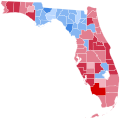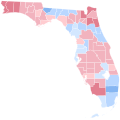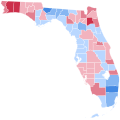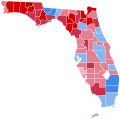 | |
| Number of elections | 44 |
|---|---|
| Voted Democratic | 25 |
| Voted Republican | 18 |
| Voted Whig | 1 |
| Voted other | 0 |
| Voted for winning candidate | 31 |
| Voted for losing candidate | 12 |
| Elections in Florida |
|---|
 |
Florida is a state in the South Atlantic region of the United States. [1] Since its admission to the Union in March 1845, it has participated in every United States presidential elections, with the 1848 election being the first. In this election, the Whig Party won Florida's three electoral votes with 57.20% of the vote; this was its only victory in the state. [2]
Contents
- Presidential elections
- 1848 to 1856
- 1860 and 1864
- 1868 to present
- Results Maps
- See also
- Notes
- References
- Works cited
In the realigning 1860 election, Florida was one of the ten slave states that did not provide ballot access to the Republican nominee, Abraham Lincoln. [3] John C. Breckinridge emerged victorious, winning 62.23% of the vote. [4] Shortly after the 1860 election, Florida seceded from the Union and became a part of the Confederacy. [5] As a result, it did not participate in the 1864 presidential election. [6]
With the end of the Civil War, Florida rejoined the Union and participated in the 1868 presidential election. This was the sole presidential election in Florida not decided by the popular vote; instead, the state legislature chose Ulysses S. Grant. [7]
Florida voted for the Republican nominee in all three presidential elections held during the Reconstruction era. [8] [9] Shortly after, white Democrats regained control of the legislature. In 1885, they created a new constitution, followed by statutes through 1889, that disfranchised most Black people and many poor whites. [10] [11] From the end of the Reconstruction era until the 1952 presidential election, the Republican Party only won Florida once, in 1928. According to historian Herbert J. Doherty, the Republicans' victory in that election was mainly because Al Smith, the Democratic nominee, was a Catholic and opposed to Prohibition, causing many members of the Southern Baptist Convention to switch to the Republican Party. [12] The Republican victory in 1952 has been attributed to the emergence of the Pinellas Republican Party, which attracted many voters. [13]
Since the 1952 presidential election, the Democrats have only won Florida five times: in 1964, 1976, 1996, 2008, and 2012. In 2000, George W. Bush led Al Gore by less than 2,000 votes on election day, but as the recount proceeded, the gap between the two sides continued to narrow. [14] In Bush v. Gore , the Bush campaign filed a lawsuit against Gore in the U.S. Supreme Court, arguing that the recounting of votes in certain counties violated the Equal Protection Clause of the U.S. Constitution. The Supreme Court announced the halt of vote recounting. [15] After a lengthy judicial process, Bush eventually won Florida's electoral votes by a margin of only 537 votes out of almost six million cast (0.009%) and, as a result, became the president-elect. [16] However, the result sparked controversy. [17]
Florida was long a swing state; furthermore, it had been seen as a bellwether in presidential elections since 1928, only voting for the non-winner in 1960, 1992 and 2020. [18] However, with the Republican Party far exceeding its national average in Florida in the 2022 midterm elections, many analysts believe that the state has transitioned from being a Republican-leaning swing state into a reliable red state, with Democratic-leaning trends in Hillsborough County, Orange County, and Osceola County unable to offset Republican gains in Miami-Dade County, Broward County, and Palm Beach County. [19] [20] This proposition was reinforced in 2024, when Republican Donald Trump won the state by 13.1 points, a margin that was 11.6 points greater than the national popular vote.












